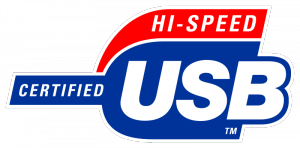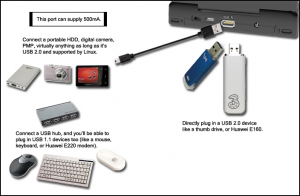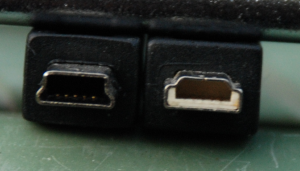Difference between revisions of "USB reference"
(last section reworked) |
|||
| Line 16: | Line 16: | ||
| '''As slave''' || yes || yes | | '''As slave''' || yes || yes | ||
|- | |- | ||
| − | | '''Charging''' || | + | | '''Charging''' || No || Yes |
|} | |} | ||
| Line 84: | Line 84: | ||
*If you have trouble connecting any device to the small OTG port, check if 'Setting->Startup->Enable/Disable services on boot->Start USB Network on bootup' is checked! This needs to be set in order to work. Default setting is unchecked (better naming of this option <strike>is planned for Hotfix5</strike> has not been included in HotFix 5, see [http://www.gp32x.com/board/index.php?/topic/56516-wishlist-for-hf5/]). | *If you have trouble connecting any device to the small OTG port, check if 'Setting->Startup->Enable/Disable services on boot->Start USB Network on bootup' is checked! This needs to be set in order to work. Default setting is unchecked (better naming of this option <strike>is planned for Hotfix5</strike> has not been included in HotFix 5, see [http://www.gp32x.com/board/index.php?/topic/56516-wishlist-for-hf5/]). | ||
| − | ''' | + | '''Mini connector''' |
[[Image:Mini-usb.png|thumb|Mini-B and Mini-A comparison]] | [[Image:Mini-usb.png|thumb|Mini-B and Mini-A comparison]] | ||
Shown here are a Mini-B connector (left, black) and a Mini-A connector (right, white). The mini-A connector should be the one you want in order to use the OTG port in host mode. Click on the image for a larger version. | Shown here are a Mini-B connector (left, black) and a Mini-A connector (right, white). The mini-A connector should be the one you want in order to use the OTG port in host mode. Click on the image for a larger version. | ||
Revision as of 15:10, 8 November 2013
The Pandora has two USB host ports:
- 1x USB 2.0 host port (USB standard-A receptacle)
- 1x USB 1.1/2.0 OTG port (USB mini-AB receptacle)
| ↓PLUGS→ | Big USB A | Small mini A USB |
| 1.0 devices | hub | yes otg |
| 2.* devices | Yes | yes otg |
| As Host | yes 500mA | yes 100mA |
| As slave | yes | yes |
| Charging | No | Yes |
If you have a question to ask, that isn't covered in this FAQ already, please ask over on the Forums. Or use feedback function below. Thank you!
Contents
USB 1.1 vs USB 2.0
USB 1.0 1.0Mbit/s Low-Speed
USB 1.1 12 Mbit/s Full-Speed
USB 2.0 480 Mbit/s Hi-Speed
Most USB ports (eg. on your computer’s motherboard, in USB hubs) actually contain two chips to allow universal compatibility – one that takes care of the Low-Speed (1.0 Mbit/s) and Full-Speed (12 Mbit/s) devices, and another one for the Hi-Speed (480 Mbit/s) devices. Low-Speed and Full-Speed are essentially the same protocols operated at different clock frequencies.
Hi-Speed is a new thing, and inherently different from the other two.
The USB 2.0 standard introduced high-speed data transmission, which requires a special controller on the host side.
Pandora’s big USB standard-A host port does not contain this second chip, since it uses too much space on the PCB. Therefore only USB 2.0 devices (bearing the “USB HI-SPEED” logo) can be plugged directly into this port. However, USB 1.1 devices can be connected to this port through a USB hub, provided the hub bears the “USB HI-SPEED” logo, meaning it is 2.0 compatible.
Pandora’s USB OTG (mini-AB) port is fully compatible with both USB 1.1 and USB 2.0, allowing it to host either type of device.
Know the difference
As a very general guide:
- Common Low-Speed and Full-Speed devices often include keyboards, mice, headsets, older USB devices.
- Common Hi-Speed devices often include cameras, PMPs, HDDs, hubs, card readers, thumb drives.
There are exceptions. Devices like HSDPA modems and GPS units could fall into either category. The only reliable indication of true Hi-Speed compatibility is the “USB Hi-Speed Certified” logo (right).
What works
Mouse, keyboard, thumb drives, plug and play. For more specialised USB devices (modems, ethernet adapters, USB displays...) it needs to be supported by a linux driver. see USB_compatibility_list If you intend to purchase USB accessories for use with Pandora and it isnt on the list, you should first research to find out if there is Linux support for said device.
“host”
A USB host port “hosts” any device that you plug in, the same as the USB ports on your computer. Pandora’s full size USB A port can host USB 2.0 devices, (but only if they are high speed compliant) it provides up to 500mA of current (the maximum allowed according to USB standards 2.5Watt. Usb voltage is 5V)
USB standard-A
- Fo example: Directly plug in a Hi-Speed USB 2.0 device such as a thumb drive, or a Huawei E160 modem.
- Using a USB standard-A to USB standard-B (or mini-B, micro-B, depending on what's on the device) cable, connect Hi-Speed USB 2.0 devices such as cameras, PMPs, and HDDS.
Devices that are not Usb 2.* For other non-Hi-Speed USB devices such as keyboards, mice, or a Huawei E220 modem. You need a usb hub in between, which translates, or you can use the smaller usb port which has support for both.
Devices that require more power. USB HDDs, very few of these can draw sufficient power from a single USB port. If its a powered HDD its ok, otherwise a powered USB hub is necessary.
USB OTG (mini-AB) port
How you connect a device to the mini-AB OTG port depends on the device's USB connector. OTG stands for On The Go.
Allows you to connect any USB 2.0-compliant device (Hi-Speed, Full-Speed, Low-Speed, including USB 1.1 ones) directly, without the use of a hub.
This port can act as a host port for USB 1.1 and USB 2.0 devices. It can supply a maximum of 100mA in host mode. (if you need more use the USB standard A (500mA)) USB OTG ports can operate in two different modes. When connected through this port, the Pandora can also act as a device, for example when connected to a computer for charging & data transfer. For this mode, you need a standard-A to mini-B cable.
- standard-B receptacle: Use a mini-A to standard-B cable.
- mini-B receptacle: Use a mini-A to mini-B cable.
- micro-B receptacle: Use a mini-A plug to standard-A receptacle adapter and a standard-A to micro-B cable.
- standard-A plug: Use a mini-A plug to standard-A receptacle adapter.
- mini-A plug: No extra cable or adapter needed.
- micro-A plug: No standardized solution exists.
Notes: Although this port implements On The Go functionality, it can not get an official On The Go certification because the OTG specification requires a device to have exactly one USB port. (The Pandora has two.) The mini-AB connector used on the Pandora has been taken out of that specification in 2007 despite being widely adopted.
- mini-A and mini-AB connectors have been removed from the present USB standard.
- If you have trouble connecting any device to the small OTG port, check if 'Setting->Startup->Enable/Disable services on boot->Start USB Network on bootup' is checked! This needs to be set in order to work. Default setting is unchecked (better naming of this option
is planned for Hotfix5has not been included in HotFix 5, see [1]).
Mini connector
Shown here are a Mini-B connector (left, black) and a Mini-A connector (right, white). The mini-A connector should be the one you want in order to use the OTG port in host mode. Click on the image for a larger version.
With the right connector, it is not necessary to switch the mode of the port[2], it will be done automatically. It may also be possible to force a mode switch, but this has not been clarified by the devs, and could result in two devices both attempting to power the port (which is not recommended)
"slave"
Pandora as USB slave
Using a USB standard-A to mini-B cable (the kind you probably own several of), you can:
- Transfer data to/from Pandora
- Charge Pandora's battery.
To enable data transfer for SD cards, run SD-Mass Storage (in the System category).
Note:
- Charging Pandora from your computer's USB port is best done with Pandora in standby mode. The current provided by your computer will probably not be sufficient to provide a quick charge while Pandora is being used.
- There are USB standard-A to mini-B cables that can be used to charge your Pandora but don't work to transfer data to/ from the Pandora! In MSWindows you will get the error: "An unknown device connected". Try using a different cable.
USB1.1 device work on the Pandora OTG (On The Go) port with the appropriate adapter, active USB extension cable, since the OTG port accepts USB 1.1 devices.
A USB standard-A male to USB standard-A female cable will not work as a hub.
There are some devices that do not work at High Speed, and thus require a High Speed hub, but at the same time require more than the usual 100 mA. To provide the extra power, the hub used must be a powered hub (one that has a power cord you can plug in to the wall).




